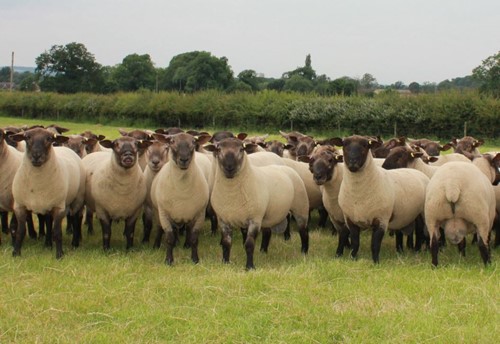Using performance recording in crossbred ram breeding
Why is performance recording important for ram breeding flocks?
Ram breeding provides the genetics to increase the productivity of your customer’s flock. Performance recording means you can select and market the sheep with the most profitable genetics. Recording crossbred rams uses the same process as a pedigree flock, but you should consider:
- Hybrid vigour
- Ram and progeny uniformity
- Comparison of sheep
How to record your flock?
Collect information at key timings throughout the season:
- Single sire mate your ewes and record sire groups (record the breed of parents if not already on Signetdata.com)
- Lambing records
- Weights:
- - 8-week weight when lambs are 6–12 weeks
- - Scan weight when most lambs average 40 kg
- Option to ultrasound scan lambs at the scan weight timing
Hybrid vigour
Hybrid vigour is when two different breeds are crossed and results in a lift in progeny performance; this is highest when the two are very different breeds. When crossbreds are mated back to founder breeds or other crossbreds, the benefit from hybrid vigour reduces.
Hybrid vigour can mask the true genetic merit of sheep and reduces over generations, so in a breeding program, this is not beneficial. The evaluation has been designed to account for hybrid vigour and show a sheep’s true genetic merit.
Hybrid vigour is commonly exploited on commercial farms, using first-generation crosses. This can be achieved using composite and pedigree/pure sires crossed to a different maternal breed.
Ram and lamb uniformity
Variation is necessary in a breeding program to select the best genetics. However, highly variable genetics can be an issue on commercial farms, making management and lamb marketing difficult.
First cross lambs have relatively uniform genetics, as they receive 50% from each of the parent breeds. Breeding from first cross lambs will produce highly variable lambs and can lead to lambs by the same sire appearing to be from one of the two founder breeds. For rams to be used commercially, it is important they are stabilised, so they produce uniform lambs. This is achieved by mating crossbred animals to a founder breed or other crossbred animals for several generations.
When back-crossing to the foundation breeds or other crossbred animals, it is important to consider inbreeding. Use Signet’s online inbreeding calculator to monitor and manage any inbreeding when stabilising a composite breed.
Comparison of rams
Each breed has its own breed-specific base used to calculate the EBVs and benchmarks. When using the benchmark for crossbred rams, it is important to check the dominant breed of the rams to make comparisons to other sheep of the same breed (or dominant breed) to see how their genetics compare. Composite rams can be compared across breed using the breed conversion tables to adjust EBVs.
The dominant breed is calculated from an animal’s pedigree and is the breed that is the highest proportion.
More information can be found in our fact sheet
Why is performance recording important for ram breeding flocks?
Ram breeding provides the genetics to increase the productivity of your customer’s flock. Performance recording means you can select and market the sheep with the most profitable genetics. Recording crossbred rams uses the same process as a pedigree flock, but you should consider:
- Hybrid vigour
- Ram and progeny uniformity
- Comparison of sheep
How to record your flock?
Collect information at key timings throughout the season:
- Single sire mate your ewes and record sire groups (record the breed of parents if not already on Signetdata.com)
- Lambing records
- Weights:
- - 8-week weight when lambs are 6–12 weeks
- - Scan weight when most lambs average 40 kg
- Option to ultrasound scan lambs at the scan weight timing
Hybrid vigour
Hybrid vigour is when two different breeds are crossed and results in a lift in progeny performance; this is highest when the two are very different breeds. When crossbreds are mated back to founder breeds or other crossbreds, the benefit from hybrid vigour reduces.
Hybrid vigour can mask the true genetic merit of sheep and reduces over generations, so in a breeding program, this is not beneficial. The evaluation has been designed to account for hybrid vigour and show a sheep’s true genetic merit.
Hybrid vigour is commonly exploited on commercial farms, using first-generation crosses. This can be achieved using composite and pedigree/pure sires crossed to a different maternal breed.
Ram and lamb uniformity
Variation is necessary in a breeding program to select the best genetics. However, highly variable genetics can be an issue on commercial farms, making management and lamb marketing difficult.
First cross lambs have relatively uniform genetics, as they receive 50% from each of the parent breeds. Breeding from first cross lambs will produce highly variable lambs and can lead to lambs by the same sire appearing to be from one of the two founder breeds. For rams to be used commercially, it is important they are stabilised, so they produce uniform lambs. This is achieved by mating crossbred animals to a founder breed or other crossbred animals for several generations.
When back-crossing to the foundation breeds or other crossbred animals, it is important to consider inbreeding. Use Signet’s online inbreeding calculator to monitor and manage any inbreeding when stabilising a composite breed.
Comparison of rams
Each breed has its own breed-specific base used to calculate the EBVs and benchmarks. When using the benchmark for crossbred rams, it is important to check the dominant breed of the rams to make comparisons to other sheep of the same breed (or dominant breed) to see how their genetics compare. Composite rams can be compared across breed using the breed conversion tables to adjust EBVs.
The dominant breed is calculated from an animal’s pedigree and is the breed that is the highest proportion.
More information can be found in the factsheet
